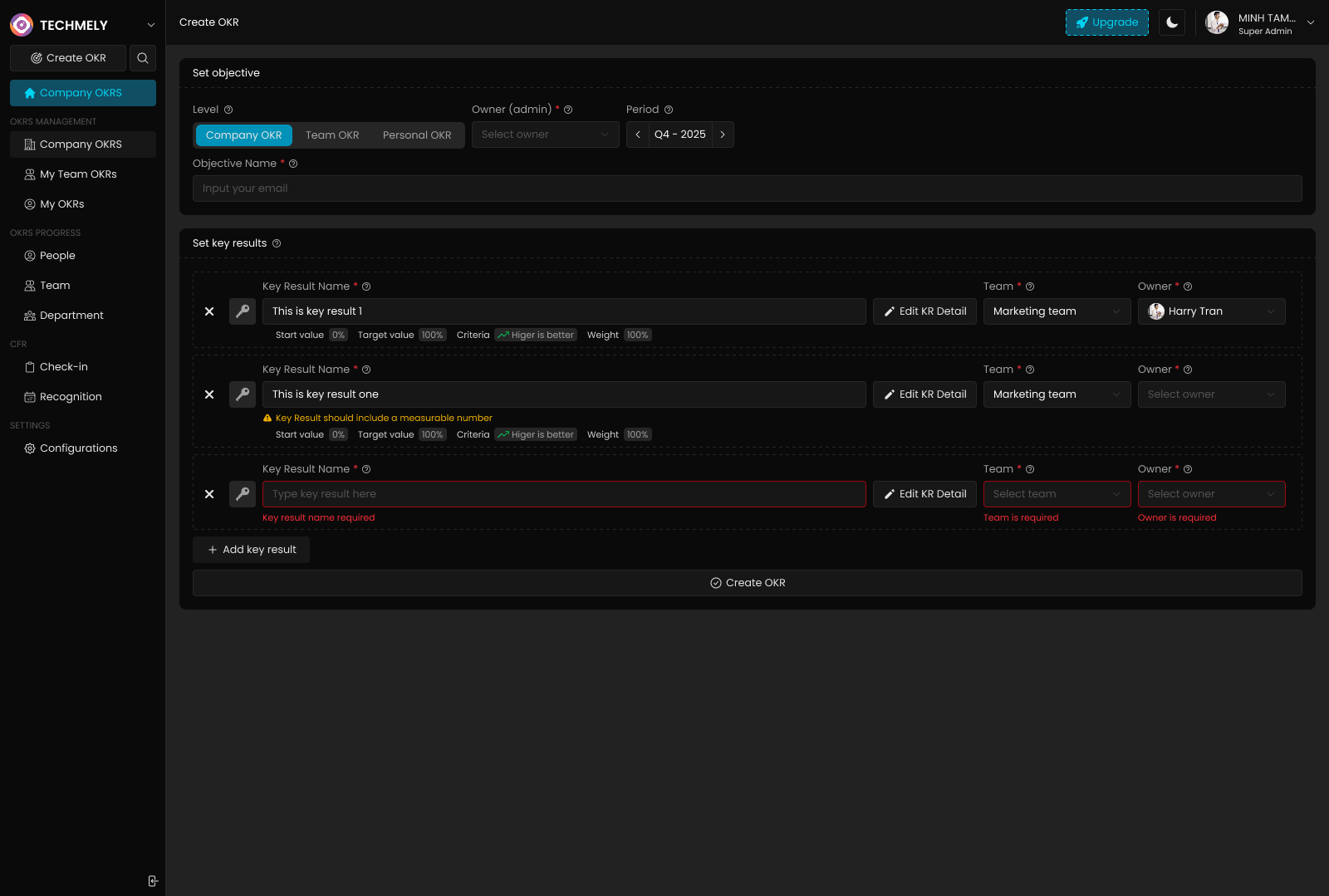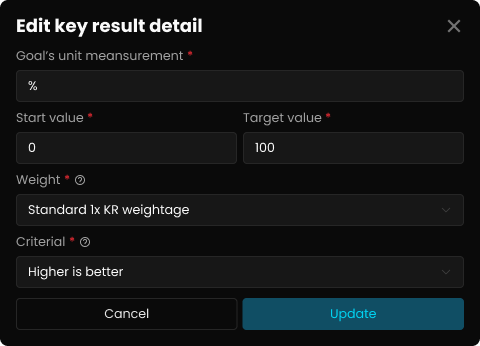Create Company-Level OKR
Complete guide to creating company-level Objectives and Key Results in AntOKR
Create Company-Level OKR
Overview
Company-level OKRs are strategic objectives that define the organization's top priorities for a specific period. These high-level goals are typically set by senior leadership and cascade down to drive alignment across all teams and individuals in the organization.
What are Company-Level OKRs?
Company-level OKRs represent the most critical outcomes that your organization needs to achieve. They are:
- Strategic: Focused on long-term business outcomes
- Ambitious: Set challenging but achievable targets
- Measurable: Include specific, quantifiable key results
- Time-bound: Have clear deadlines and timeframes
- Aligned: Support the company's mission and vision
Prerequisites
Before creating company-level OKRs, ensure you have:
- Administrator privileges - Only administrators can create company-level OKRs
- Strategic clarity - Clear understanding of company priorities
- Leadership alignment - Buy-in from senior management
- Measurement framework - Defined metrics and tracking methods
Step-by-Step Guide
Step 1: Access the Create OKR Interface
Navigate to the OKR creation page and select the Company level option.

- Click on "Create OKR" from your dashboard
- In the Level section, select "Company OKR"
- Choose the appropriate Period (Q4 - 2025 in the example)
- Set the Owner (typically CEO or senior executive)
Step 2: Define Your Objective
The objective should be a bold, qualitative statement that describes what you want to achieve.
Best Practices for Company Objectives:
- Keep it inspiring and motivational
- Make it broad enough to encompass multiple initiatives
- Ensure it aligns with company strategy
- Use clear, simple language that everyone can understand
Example Objectives:
- "Become the leading OKR management platform in Southeast Asia"
- "Achieve sustainable profitability while maintaining growth"
- "Transform customer experience through digital innovation"
Step 3: Set Key Results
Key Results are specific, measurable outcomes that indicate progress toward your objective.

For each Key Result, define:
Key Result Details
- Goal's unit measurement: Choose the appropriate unit (%, $, number, etc.)
- Start value: Current baseline (typically 0)
- Target value: Desired end result (e.g., 100 for percentage)
- Weight: Relative importance (Standard 1x KR weightage)
- Criteria: How success is measured (Higher is better, Lower is better)
Assignment and Ownership
- Team: Select the responsible team
- Owner: Assign a specific individual accountable for this key result
Example Key Results for Company OKRs:
- "Increase annual recurring revenue from $2M to $5M"
- "Achieve 95% customer satisfaction score"
- "Expand to 3 new markets in Southeast Asia"
- "Reduce customer churn rate from 15% to 8%"
Step 4: Review and Create
Before finalizing your company OKR:
- Validate alignment - Ensure objectives support company strategy
- Check measurability - Verify all key results are quantifiable
- Confirm ownership - Make sure each element has a clear owner
- Review timeline - Validate the period is appropriate
- Assess achievability - Ensure targets are challenging but realistic
Click "Create OKR" to finalize your company-level objective.
Best Practices for Company OKRs
1. Limit the Number
- Keep to 3-5 company objectives per quarter
- Focus on what matters most to avoid dilution of effort
2. Ensure Executive Sponsorship
- Each objective should have a C-level or VP sponsor
- Regular executive reviews and updates are essential
3. Cascade Alignment
- Company OKRs should cascade to team and individual levels
- Create clear line of sight from individual work to company goals
4. Regular Monitoring
- Weekly or bi-weekly progress reviews
- Monthly leadership alignment meetings
- Quarterly comprehensive assessments
5. Communicate Broadly
- Share company OKRs with entire organization
- Explain the "why" behind each objective
- Celebrate progress and learnings
Common Mistakes to Avoid
Setting Too Many Objectives
- More than 5 objectives dilute focus
- Quality over quantity approach works better
Making Objectives Too Operational
- Company OKRs should be strategic, not tactical
- Avoid objectives that are just regular business activities
Lack of Measurement
- Every key result must be quantifiable
- Avoid vague or subjective metrics
Poor Ownership Assignment
- Each objective and key result needs a clear owner
- Shared ownership often leads to no ownership
Integration with Team and Personal OKRs
Company OKRs serve as the foundation for organizational alignment:
- Team OKRs should directly or indirectly support company objectives
- Personal OKRs can align with either company or team objectives
- Use objective linking to create clear connections
Tracking and Updates
Progress Monitoring
- Update key result progress regularly (weekly/bi-weekly)
- Use the progress tracking features in AntOKR
- Document challenges and blockers
Review Cycles
- Weekly: Quick progress checks with owners
- Monthly: Detailed review with leadership team
- Quarterly: Comprehensive assessment and planning
Next Steps
After creating your company OKRs:
- Communicate: Share with the entire organization
- Cascade: Help teams create aligned team OKRs
- Monitor: Set up regular review and update processes
- Iterate: Learn and improve for the next planning cycle
Troubleshooting
Access Issues
If you cannot create company-level OKRs, verify that you have administrator privileges in your AntOKR account.
Alignment Challenges
If teams struggle to align with company OKRs, consider:
- Breaking down company objectives into smaller components
- Providing clearer context and reasoning
- Facilitating alignment workshops
Measurement Difficulties
For hard-to-quantify objectives:
- Use proxy metrics that indicate progress
- Combine quantitative and qualitative measures
- Regular stakeholder feedback and assessment
Company-level OKRs are the cornerstone of organizational alignment and strategic execution. When done well, they provide clarity, focus, and motivation for the entire organization to work toward common goals.
Suggested Related Articles
Department Management
Complete guide to creating, managing, and organizing departments and teams within your AntOKR organization
OKR Progress Tracking
Complete guide to tracking and monitoring OKR progress across departments, teams, and individuals with detailed analytics and insights
OKR Management Overview
Complete guide to navigating and understanding OKR management interface across Company, Team, and Personal levels
Key Result Actions
Complete guide to managing key result actions including updating progress, editing details, changing ownership, and deleting key results
Login
How to access your AntOKR account
Create Company
Learn how to set up your company profile in AntOKR with step-by-step instructions